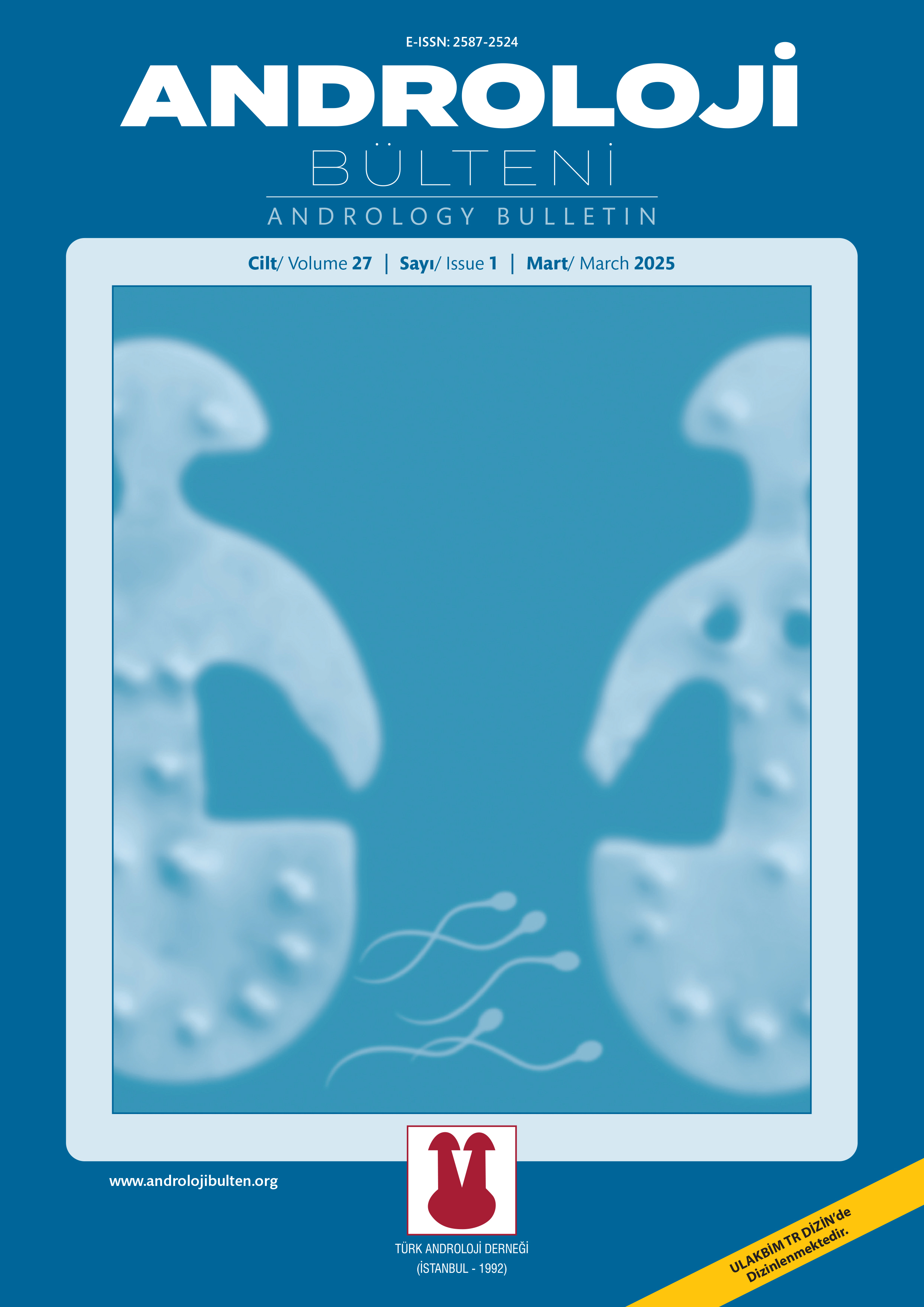
Content of this journal is licensed under a Creative Commons Attribution-NonCommercial 4.0 International License.
Evaluation of non-invasive diagnostic methods in male lower urinary tract symptoms using pressure-flow studies
İsmail Emre Ergin1, Hüseyin Saygin2, Abuzer Öztürk3, Arslan Fatih Velibeyoğlu2, Emre Kıraç3, Aydemir Asdemir2, Esat Korgali21Department of Urology, Etlik City Hospital, Ankara, Türkiye2Department of Urology, Faculty of Medicine, Sivas Cumhuriyet University, Sivas, Türkiye
3Clinic of Urology, Sivas Numune Hospital, Sivas, Türkiye
OBJECTIVE: This study aims to determine the importance of noninvasive diagnostic parameters such as intravesical prostatic protrusion (IPP), bladder wall thickness, prostate volume, and uroflow in the detection of bladder outlet obstruction using pressure-flow studies.
MATRERIAL and METHODS: Pressure flow studies were performed on patients who presented to the outpatient clinic with lower urinary tract symptoms. Patients were divided into two groups, those with and without obstruction, according to the Bladder Outlet Obstruction Index (BOOI) parameter. Differences between the two groups were evaluated in terms of prostate volume, IPP, Bladder Wall Thickness (BWT), uroflow peak flow rate (Qmax), post-void residual urine volume and Bladder Outflow Obstruction Number (BOON) parameters.
RESULTS: There was a significant difference in prostate volume, IPP, BWT, uroflow peak flow rate, post-void residual urine volume and BOON parameters between the obstructed and non-obstructed groups. In the ROC analysis performed to predict the obstructed patient, the ideal cut-off value for prostate volume was determined as 71.5 ml, for IPP 10.5 mm, for BWT and 5.3 mm. Bladder outlet obstruction index parameter was positively correlated with prostate volume, IPP, BWT, residual volume and IPSS. There was a negative correlation with Qmax.
CONCLUSION: In the ROC curve for predicting obstructed patients, IPP showed a higher AUC (area under the curve) compared to prostate volume and BWT, indicating IPP’s superior predictive value for obstruction. Uroflow parameters are also significant predictors, albeit less so than IPP. Increasing obstruction scores correlate with higher levels of prostate volume, IPP, uroflow peak flow, and IPSS, providing insights into the severity of obstruction.
Erkek alt üriner sistem semptomlarında non-invaziv tanı metotlarının basınç akım çalışması kullanarak değerlendirilmesi
İsmail Emre Ergin1, Hüseyin Saygin2, Abuzer Öztürk3, Arslan Fatih Velibeyoğlu2, Emre Kıraç3, Aydemir Asdemir2, Esat Korgali21Etlik Şehir Hastanesi, Üroloji Ana Bilim Dalı, Ankara, Türkiye2Cumhuriyet Üniversitesi Tıp Fakültesi, Üroloji Ana Bilim Dalı, Sivas,Türkiye
3Sivas Numune Hastanesi, Üroloji Kliniği, Sivas, Türkiye
AMAÇ: Mesane çıkım tıkanıklığının tespiti günümüzde altın standart olarak basınç-akım çalışması ile yapılmaktadır. Fakat basınç-akım çalışmalarının invazif bir işlem olması yaygın kullanımını sınırlamaktadır. Biz bu çalışmada İntravezikal prostatik protrüzyonu (IPP), mesane duvar kalınlığı, prostat hacmi, üroflow gibi non-invazif tanısal parametrelerin mesane çıkım tıkanıklığının tespitindeki önemini basınç-akım çalışmalarını kullanarak tespit etmeyi amaçlamaktayız.
GEREÇ ve YÖNTEMLER: Alt üriner sistem semptomları ile polikliniğe başvuran hastalara basınç akış çalışmaları yapıldı. Hastalar, Mesane Çıkış Obstrüksiyonu Endeksi (BOOI) parametresine göre obstrüksiyonu olan ve olmayanlar şeklinde iki gruba ayrıldı. İki grup arasındaki farklar prostat hacmi, IPP, Mesane Duvar Kalınlığı (BWT), üroflow zirve akış hızı (Qmax), işeme sonrası rezidüel idrar hacmi ve Mesane Çıkış Obstrüksiyon Numarası (BOON) parametreleri açısından değerlendirildi.
BULGULAR: Obstrüksiyonu olan ve olmayan gruplar arasında prostat hacmi, IPP, BWT, üroflow max akış hızı, işeme sonrası rezidüel idrar hacmi ve BOON parametrelerinde anlamlı fark bulundu. Obstrüksiyonu tahmin etmek için yapılan ROC analizinde, prostat hacmi için ideal kesim değeri 71,5 ml, IPP için 10,5 mm, BWT için 5,3 mm olarak belirlendi. Mesane çıkım tıkanıklık indeksi parametresi prostat hacmi, IPP, BWT, rezidüel hacim ve IPSS ile pozitif korelasyon gösterdi. Qmax ile negatif korelasyon bulundu.
SONUÇ: Obstrükte hastayı öngörmede yapılan ROC eğrisinde AUC’nin IPP’de prostat volümü ve MDK’a olan görece fazlalığı daha değerli obstrüksiyon öngörücüsü olduğunu göstermektedir. Çalışmamızda üroflow parametreleri için AUC’nin IPP kadar olmasa da kayda değer yükseklikte obstrüksiyonu öngörebilecek parametreler olduğu söylenebilir. Obstrüksiyon skoru arttıkça prostat hacmi, IPP, üroflov tepe akımı, IPSS nin korele olarak artması obstrüksiyonun şiddeti hakkında yorum yapmamızı sağlayacaktır.
Manuscript Language: English
(91 downloaded)













